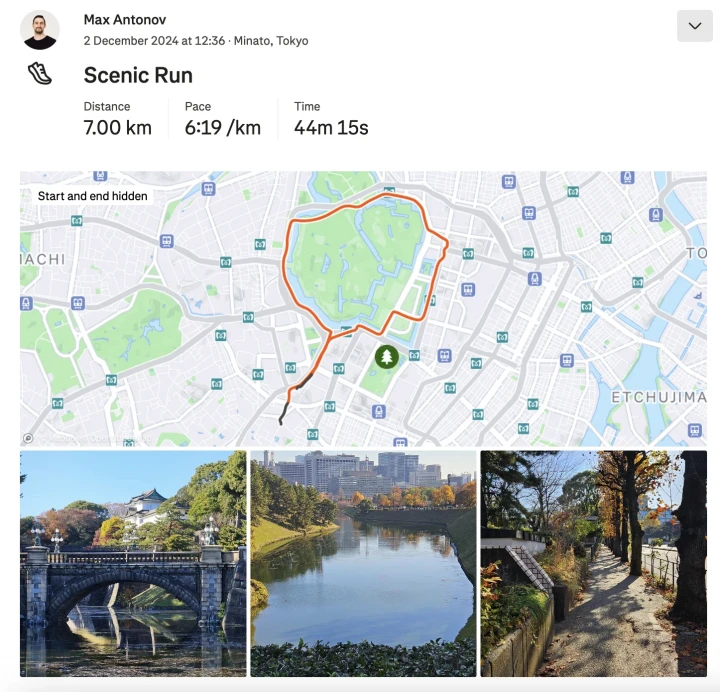My version? No likes, no algorithms. Just me.
-
I went for a scenic run around the Imperial Gardens in Tokyo—a 5-kilometre loop encircling the grounds. The path follows the palace’s moat, offering views of historic stone walls and traditional bridges. So good!

-
Key takeaways from Lenny's podcast: "Identify your bullseye customer in one day | Michael Margolis"
That’s the promise of the Bullseye Customer Sprint, a framework shared by Michael Margolis (UX Research Partner at GV). It’s all about focusing on the right customer at the start of your journey—avoiding wasted effort and accelerating clarity for your team.Imagine saving months of work on a product idea—by getting it right in one day.
Instead of chasing broad customer profiles, Margolis advises narrowing down to a small, specific group with shared needs and behaviors. Teams identify these customers through key questions, selecting five for interviews in a structured sprint. Over one day, they observe reactions to three distinct product prototypes, gathering insights from customer feedback and past experiences. This process reveals what resonates, avoids reliance on hypotheticals, and pinpoints what to prioritise or skip.
Clarity is the reward. Margolis’s framework ensures teams refine their product-market fit and move forward with confidence, a blueprint detailed in his book Learn More Faster.
Here’s how it works:
1. Define your Bullseye Customer.- It’s the most likely group to adopt your product—not your entire target market.
- Narrowing down feels comically specific but is key (think "users who buy refrigerated specialty meds").
- Use seven-ish criteria: demographics, past behaviours, trigger events, etc.
2. Talk to the right people.- Run short, focused interviews with five bullseye customers.
- Spend the first half uncovering their past experiences—because what they’ve done matters more than what they say they’ll do.
- Share 3 simple prototypes to learn what resonates (or doesn’t).
3. Make it a team sport.- Host “watch parties” for the whole team to observe live interviews.
- Assign roles for note-taking and debriefing.
- Align quickly—so everyone’s clear on what’s next by the end of the day.
4. Compare Prototypes to Uncover What Works.- Create 3 distinct versions of your concept—each with clear, contrasting value propositions.
- Avoid perfecting the design; focus on the messaging and what each version promises.
- Watch for patterns in what customers love, ignore, or critique to identify the most valuable features.
5. Prioritise Past Behaviour Over Predictions.- People often overestimate what they’ll do in the future.
- Anchor your insights on their past actions and experiences—how they’ve solved similar problems before.
- This approach reduces guesswork and gives you confidence in building solutions that match real-world needs.
-
Everything feels small in Tokyo—apartment blocks, windows, balconies, even doors. It’s so tiny that in some places, I don’t quite fit!

-
Culture is shaped by the people within it. Sometimes, one person is all it takes to spark positive change.
An employee who offers genuine encouragement, lends a hand to solve a problem or suggests small but meaningful improvements can transform a team’s energy — one action at a time.
This is the quiet yet powerful force of influence.
Amplify their voices.
Support them.
Elevate them.
Let their impact ripple further. -
A must read: The Cold Email Handbook
1. Why cold outbound is such a game-changer.- Direct access to decision-makers. Unlike ads or social posts, a well-crafted email goes straight to the inbox of your ideal contact—no gatekeepers.
- High ROI potential. A single person with a laptop can create millions in pipeline, as seen with campaigns that booked 23 meetings worth $230k in pipeline in just 4 weeks.
- Timeless appeal of email. Amidst internet noise, email remains a sacred space for genuine conversations.
2. The two biggest challenges—and how to solve them.- Writing emails that get replies. Start with the basics: understand your prospect's pain points, craft a compelling value proposition, and keep it personal.
- Scaling personalization. AI can now handle the grunt work—research, variable insertion, and even crafting unique hooks—without losing that human touch.
3. The infrastructure you need to succeed.- Adjacent domains are key. Avoid penalties by sending from additional domains, not your primary one.
- Deliverability matters. Set up SPF, DKIM, and DMARC to stay out of spam folders. Warm your inboxes gradually to earn ESP trust.
- A systematic approach to scale. Tools like Za-zu automate everything from sending personalised emails to testing multiple campaign variables.
4. Crafting emails that cut through the noise.- Focus on value, not fluff. Show how your solution makes money, saves time, or reduces costs—these are the triggers that drive responses.
- Personalisation is your unfair advantage. Go beyond “Hi [Name]”—reference specific company milestones, current challenges, or even their job postings to grab attention.
- Keep it brief. Under 200 words. Every line should build curiosity and drive the recipient toward a clear, simple next step.
5. Testing and optimising for results.- A/B testing at scale. Experiment with subject lines, messaging, and value propositions to identify what resonates.
- Monitor performance metrics. Track open, reply, and conversion rates for each email variant and stage. Use insights to refine future campaigns.
- Iterate and scale. Double down on what works—adjust messaging or focus areas dynamically based on campaign results.
-
Silos.
Break them whenever you see them.
Silos keep teams from seeing the whole market picture.
Silos risk losing sight of the customer, prioritising internal goals and creating a fragmented experience.
Silos slow everything down - teams hold onto information, delaying solutions.
Silos leave teams blind to risks outside their scope. -
Expertise vs open-mindedness.
Sometimes it’s hard to tell if someone’s perspective is genuinely the best approach or if they’re just anchored in familiar thinking. What if they don’t even know what “awesome” could look like?
On the other hand, knowing when to hold your ground versus when to let things go can be even trickier. What if I don’t know what “awesome” feels like and am just comfortable with my usual approach? -
Define who’s making the call before a debate starts.
That person takes in everyone’s input but in the end they own the final decision.
It cuts down on endless debates and helps the team align around a single direction—even if not everyone agrees at first. -
Marathon done! ✅
What an incredible experience. Running across the Sydney Harbour Bridge and soaking in the amazing views was unforgettable. The support along the course was fantastic, with spectators holding up funny signs like "Don't be shit" that kept me laughing.
I finished in 5h 10m—not the fastest, but my goal was to finish, so I didn’t push too hard.
My plan was to stay in Zone 2 for the first 15km, then stick to Zone 3 as long as possible and I managed to do just that. I hit a couple of cramps in the second half but powered through with cramp shots (disgusting, but they work).

Everything went smoothly, from pacing to nutrition, so I’m really happy with it.
Next year, now that I know what to expect, I’ll be ready to push harder! 💪

-
A short post about unstoppable teams.
-
Sharing problems doesn’t mean solving them.
Early in a product management career, it’s tempting to package every problem with a solution. It feels efficient and helpful but it can limit your team’s creativity. Presenting ready-made answers shifts focus from understanding the problem to critiquing your idea. This shortcut skips the messy, collaborative process where the best solutions often emerge.
Teams thrive when they tackle challenges together. Give them the problem—leave space for their brilliance. -
Aug 3
If you’re a Product Manager, let the Product Designer lead when they’re handling tasks well.
Shift your focus to strategy or collaboration, stepping in only if quality slips—then step back again. -
The term "agile" gets thrown around so much that it’s often misunderstood. True agility means adapting quickly to market changes without causing major disruptions—not rushing into decisions without a plan.
Always remember: agility is a delivery method, not a strategy.
Agile vs Strategy -
Hyrox done! ✅
Happy that I finished but not quite happy with the time. I was aiming for ~1h 30m, but it was a bit heavy today.
Will do it again next year!

-
Jul 10
Using no-reply emails puts up a barrier and can leave customers feeling ignored.
Instead, businesses should use email addresses that invite replies and ensure responses. It’s a simple way to build stronger relationships and gather valuable feedback. -
Jun 26
TIL. Radio stations use the Radio Data System (RDS) to send song information alongside their broadcast. RDS embeds digital data into the FM signal without interfering with the audio.
The data travels on a subcarrier frequency—a portion of the FM signal reserved for extra information. This allows song titles, artist names, and station details to display on your car's radio screen. Simple, seamless and clever.

-
Jun 26
Both product managers (PMs) and product designers (PDs) often engage in activities like talking to customers, generating feature ideas and suggesting UX improvements.
When responsibilities overlap, PMs should step back if PDs are excelling in their role. Instead, PMs can concentrate on strategy and collaboration across the organisation -
Working at a small tech business offers unmatched opportunities. You’re involved in everything—from strategy to customer service. It’s a fast track to building skills across the board.
-
Jun 18
If the user experience needs explaining, it’s not a good one.
Clarity should be baked into design. The best experiences guide users seamlessly, answering questions before they arise and making every interaction intuitive.
Explanations only highlight what’s broken. A great user experience speaks for itself.
Pedestrian crossing or not?

-
Jun 14
Tactical decisions for short-term revenue often clash with long-term strategy. They’re unavoidable in business. Balancing these moments without losing sight of the bigger picture defines strong leadership.
